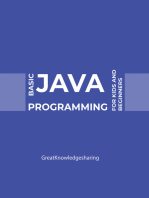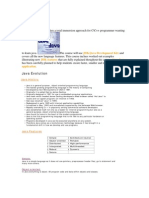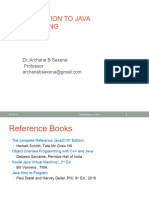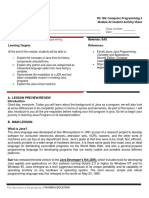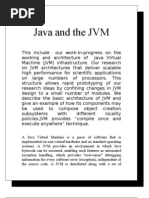0 ratings0% found this document useful (0 votes)
16 viewsHow Java Works
Uploaded by
soumitrasssCopyright
© © All Rights Reserved
We take content rights seriously. If you suspect this is your content, claim it here.
Available Formats
Download as PDF, TXT or read online on Scribd
0 ratings0% found this document useful (0 votes)
16 viewsHow Java Works
Uploaded by
soumitrasssCopyright
© © All Rights Reserved
We take content rights seriously. If you suspect this is your content, claim it here.
Available Formats
Download as PDF, TXT or read online on Scribd
You are on page 1/ 1
How Java Works
For most programming languages, a program is translated (compiled) into a machine-language program. Then,
the machine language program can be executed (or run).
But different computers, or machines, can have different instruction sets. Also, for example, integers may be
implemented in words with different sizes on different computers, so that integer overflow might happen differently.
So there are many ways in which the same program run on different computers could give different results.
The Java Virtual Machine —JVM
Java is different. When Java was released in 1995, it had the goal that a Java program developed on any
computer would run exactly the same on any other computer. It had to, because many Java programs would be
written as applets, to be run in a browser page on the internet, on any computer.
To achieve what is called platform independence, Java bytecode was designed: A fake machine language for a
fake machine —also called a fake computer, a Virtual Machine, or VM. To use Java on a new machine, one has to
1. Write a compiler on that machine that translates Java into Java bytecode.
2. Write an interpreter for Java bytecode —that is, write a program that reads and executes programs
written in bytecode. That interpreter is, then a Java Virtual Machine.
Of course, running an interpreter, a software program, is much slower than executing a machine-language
program, and that was a big drawback initially. But people found ways to improve the speed. One important way
was the introduction of Just-In-Time compilers that could quickly translate some Java bytecode into the real
machine language and then execute the bytecode. Moreover, once Java was firmly established, hardware
manufacturers began offering hardware support for Java.
However, languages like C and C++, which are always compiled directly into machine language, will always be
somewhat faster than Java. Because of this, methods have been developed to allow calling C or C++ procedures
from a Java program. This allows one to use Java for most of the coding but to write crucial methods that have to be
fast in C or C++.
To read more about Java, its implementation, and its history, visit
https://en.wikipedia.org/wiki/Java_(programming_language)
JREs and JDKs
A Java Runtime Environment (JRE) is a software package that contains everything needed to execute a Java
program. It includes the interpreter for Java bytecode —the Java Virtual Machine. It also includes the class library
—Java bytecode for all the classes that accompany Java, like String, Character, and JFrame. And there is also a class
loader, which among other things, allocates memory for static variables and calls code to initialize them.
Some small computers —like smart phones— won’t have a Java compiler on them (see below), but they might
have a JRE so that they can execute or run Java programs that have been translated into Java bytecode.
A Java Development Kit (JDK) is a software package that contains not only a JRE but a Java compiler, so that
Java programs can be compiled/translated into Java bytecode. There are several versions of the JDK. The major one
can be found here (as of 2018 January): http://www.oracle.com/technetwork/java/javase/downloads/index.html.
ÓDavid Gries, 2018
You might also like
- Computer Science Faculty: Nangarhar UniversityNo ratings yetComputer Science Faculty: Nangarhar University25 pages
- R.P. Bhalodia BCA College: History of JavaNo ratings yetR.P. Bhalodia BCA College: History of Java33 pages
- JDB - Java Debugger, Which Help Us To Find Errors in Our ProgramsNo ratings yetJDB - Java Debugger, Which Help Us To Find Errors in Our Programs6 pages
- APznzabS03alwV8LTFhBXk0Zpo-bTMxhar8K5WMTvRjHFpHIccmiJDDopbQS1eavm3fHgOxo-DBiKupZ_i88fSnZJ33kJsSLxWcVGqLHx8...GGlMcaDzM3X7tsIRPy8Fj4dXuVbf8LLPpj2Z0ROZ7veJL6sGP66Lsz_iocuDbuXAGKc_R0llENXlC_wiawaAI1OS5lvFF_GrY3BlKBYDQ0yWLHsV0PbTTPZ6BmNo ratings yetAPznzabS03alwV8LTFhBXk0Zpo-bTMxhar8K5WMTvRjHFpHIccmiJDDopbQS1eavm3fHgOxo-DBiKupZ_i88fSnZJ33kJsSLxWcVGqLHx8...GGlMcaDzM3X7tsIRPy8Fj4dXuVbf8LLPpj2Z0ROZ7veJL6sGP66Lsz_iocuDbuXAGKc_R0llENXlC_wiawaAI1OS5lvFF_GrY3BlKBYDQ0yWLHsV0PbTTPZ6Bm64 pages
- Introduction To Java: Justification For G.U.INo ratings yetIntroduction To Java: Justification For G.U.I4 pages
- Topic 1_Introduction to Java Programming (1)No ratings yetTopic 1_Introduction to Java Programming (1)14 pages
- Introduction To Java: Java Virtual Machine (JVM)No ratings yetIntroduction To Java: Java Virtual Machine (JVM)9 pages
- Lecture – 2 Introduction to Java, Key FeaturesNo ratings yetLecture – 2 Introduction to Java, Key Features5 pages
- 1- Object Oriented Programming Java(Lecture-1) 500 2No ratings yet1- Object Oriented Programming Java(Lecture-1) 500 237 pages
- JAVA: Java Programming for beginners teaching you basic to advanced JAVA programming skills!From EverandJAVA: Java Programming for beginners teaching you basic to advanced JAVA programming skills!No ratings yet
- DIVIDENDS ON PREFERENCE AND ORDINARY SHARES - Del RosarioNo ratings yetDIVIDENDS ON PREFERENCE AND ORDINARY SHARES - Del Rosario17 pages
- White Simple Business Analyst Resume_20240921_184747_0000No ratings yetWhite Simple Business Analyst Resume_20240921_184747_00001 page
- MAN0013147 TurboFect Transfection Reagent UGNo ratings yetMAN0013147 TurboFect Transfection Reagent UG2 pages
- ETABS Concrete Frame Design: Mexican RCDF 2017 Column Section Design (Envelope)No ratings yetETABS Concrete Frame Design: Mexican RCDF 2017 Column Section Design (Envelope)2 pages
- Failures Investigation & CAPA as Per Revised Schedule MNo ratings yetFailures Investigation & CAPA as Per Revised Schedule M46 pages
- Don t Forget to Write for the elementary grades 50 enthralling and effective writing lessons Ages 5 to 12 1st Edition Jennifer Traig (Editor) all chapter instant download100% (9)Don t Forget to Write for the elementary grades 50 enthralling and effective writing lessons Ages 5 to 12 1st Edition Jennifer Traig (Editor) all chapter instant download50 pages
- Lecture Plan - Chem - Spring 2022-23 - 17weekNo ratings yetLecture Plan - Chem - Spring 2022-23 - 17week3 pages
- Film As Cultural Diplomacy - South Korea's Nation Branding Through Parasite (2019) - SpringerLinkNo ratings yetFilm As Cultural Diplomacy - South Korea's Nation Branding Through Parasite (2019) - SpringerLink23 pages
- Cartasel Salvador Intl, ST Oscar Rom MSLPNo ratings yetCartasel Salvador Intl, ST Oscar Rom MSLP45 pages
- KJT Sensors - High Pressure-J12 Series: Proximity Sensor - DC Power SuppliesNo ratings yetKJT Sensors - High Pressure-J12 Series: Proximity Sensor - DC Power Supplies3 pages

